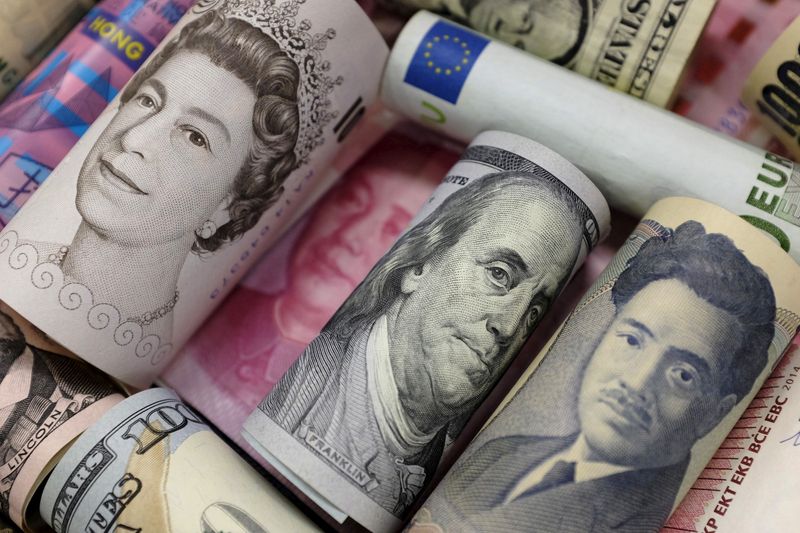By Karen Brettell
NEW YORK (Reuters) – The dollar was little changed against a basket of currencies on Tuesday as investors waited on U.S. retail sales and minutes from the Federal Reserve’s July meeting on Wednesday.
The greenback has bounced from a six-week low last week as investors ramp up bets that the U.S. central bank will continue to hike rates aggressively as inflation remains persistently high.
Trading has been choppy, however, with the Fed not due to meet until Sept. 20-21 and with more consumer price inflation and jobs data due before then.
Looser financial conditions as benchmark 10-year Treasury yields hold below 3% and as the credit and stocks markets improve has increased speculation the Fed may need to be more aggressive in tightening conditions to address rising price pressures.
“Every rally in U.S. equities gives the Fed more leeway to hike rates,” said Adam Button, chief currency analyst at ForexLive in Toronto.
ING analyst Padhraic Garvey noted that financial conditions were back to where they were in April, which was before the Fed made a cumulative 200 basis points in rate hikes, leaving the U.S. central bank almost back at square one.
“This must reverse. Else the Fed has no choice but to get tougher,” Garvey, regional head of research, Americas at ING said in a note.
Investors will scour minutes from the Fed’s July meeting on Wednesday for any new signals of how large a rate hike is likely in September.
Fed funds futures traders are currently pricing in a 60% chance of a 50 basis points increase and a 40% probability of a 75 basis points hike.
U.S. retail sales data on Wednesday will also offer new insight into the state of the consumer. It is expected to show that sales rose by 0.1% in July compared with June.
Data on Tuesday showed that U.S. homebuilding fell to the lowest level in nearly 1-1/2 years in July, weighed down by higher mortgage rates and prices for construction materials.
Industrial production, meanwhile, rose to an all-time high in July.
The dollar index against a basket of currencies was up 0.02% on the day at 106.48.
The euro climbed back into positive territory, after dropping earlier on data showing that German investor sentiment fell slightly in August on concerns the rising cost of living will hit private consumption.
Europe is struggling with an energy crisis after imposing sanctions on Russia due to its invasion of Ukraine.
Germany secured a commitment on Tuesday from major gas importers to keep two floating liquefied natural gas (LNG) terminals fully supplied from this winter in a bid to cut reliance on Russian fuel, as Moscow warned that sky-high gas prices may jump again.
“The market is slowly pricing in a worse outcome this winter in Europe and that’s the major reason the dollar’s stayed so strong,” said Button. “While the U.S. outlook is deteriorating, it still looks better than Europe and much of Asia.”
The euro rose 0.10% against the dollar to $1.0169, after earlier falling to $1.0121, the lowest since Aug. 3.
The greenback gained 0.69% against the yen to 134.22 yen.
The Japanese currency, which is often affected by the difference between benchmark yields in the United States and Japan, rallied last week on expectations that cooler U.S. inflation would mean a less aggressive pace of Fed tightening and so lower U.S. yields.
However in recent days, several Fed policymakers have spoken of the need for continued rate hikes.
The Australian dollar recovered from earlier losses to be little changed on the day.
Minutes from the Reserve Bank of Australia’s (RBA) August policy meeting on Tuesday showed that Australia’s central bank still sees a need for more rises in interest rates to prevent high inflation becoming baked into the expectations, but is not on a pre-set path and aims to keep the economy on an even keel.
The New Zealand dollar fell 0.34%, hurt by concerns about global growth. New Zealand’s central bank is expected to deliver its fourth straight half-point rate hike on Wednesday but that appeared to have been priced into the currency already.
The greenback fell 0.43% against the Canadian dollar after Canadian data showed still high underlying inflation pressures and raised bets for a hefty rate hike by the Bank of Canada next month.



